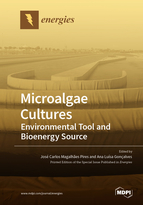Microalgae Cultures: Environmental Tool and Bioenergy Source
A special issue of Energies (ISSN 1996-1073). This special issue belongs to the section "B: Energy and Environment".
Deadline for manuscript submissions: closed (28 February 2021) | Viewed by 37919
Special Issue Editors
Interests: CO2 capture; wastewater treatment; microalgal biofuels; process modelling
Special Issues, Collections and Topics in MDPI journals
Interests: biotechnological applications of microalgae; CO2 capture; wastewater treatment; bioenergy production; circular economy; process sustainability; process integration; photobioreactor design; microalgal biomass production; high-valued compounds production
Special Issues, Collections and Topics in MDPI journals
Special Issue Information
Dear colleagues,
Microalgae have been intensively studied for CO2 capture, nutrient removal from wastewater, and biofuels production. These photosynthetic microorganisms use solar energy with efficiency ten times greater than terrestrial plants and are responsible for about 50% of the world’s oxygen production. Therefore, microalgae have been considered a sustainable solution for CO2 capture. Besides carbon, their growth also requires other macronutrients: nitrogen and phosphorus. To avoid the addition of fertilizers (increasing the production costs), these nutrients can be supplied if wastewater is used as the culture medium. The integration of biomass production with wastewater treatment enables the reduction of operational costs and the environmental impact. Microalgae are also known for their high lipid contents and high growth rates, and are a promising oil source for biodiesel production.
This Special Issue will present the recent research activities concerning the environmental applications of microalgae and their potential for biofuels production, focusing on the main challenges for their large-scale application. Since microalgal culturing can address different environmental and non-environmental issues, the achievements from the integration of multiple microalgal applications will also be considered in this Special Issue.
Prof. Dr. José Carlos Magalhães Pires
Dr. Ana Luísa Gonçalves
Guest Editors
Manuscript Submission Information
Manuscripts should be submitted online at www.mdpi.com by registering and logging in to this website. Once you are registered, click here to go to the submission form. Manuscripts can be submitted until the deadline. All submissions that pass pre-check are peer-reviewed. Accepted papers will be published continuously in the journal (as soon as accepted) and will be listed together on the special issue website. Research articles, review articles as well as short communications are invited. For planned papers, a title and short abstract (about 100 words) can be sent to the Editorial Office for announcement on this website.
Submitted manuscripts should not have been published previously, nor be under consideration for publication elsewhere (except conference proceedings papers). All manuscripts are thoroughly refereed through a single-blind peer-review process. A guide for authors and other relevant information for submission of manuscripts is available on the Instructions for Authors page. Energies is an international peer-reviewed open access semimonthly journal published by MDPI.
Please visit the Instructions for Authors page before submitting a manuscript. The Article Processing Charge (APC) for publication in this open access journal is 2600 CHF (Swiss Francs). Submitted papers should be well formatted and use good English. Authors may use MDPI's English editing service prior to publication or during author revisions.
Keywords
- biofuels
- biomass
- biorefinery
- CO2 capture
- microalgae
- photobioreactor
- wastewater treatment







